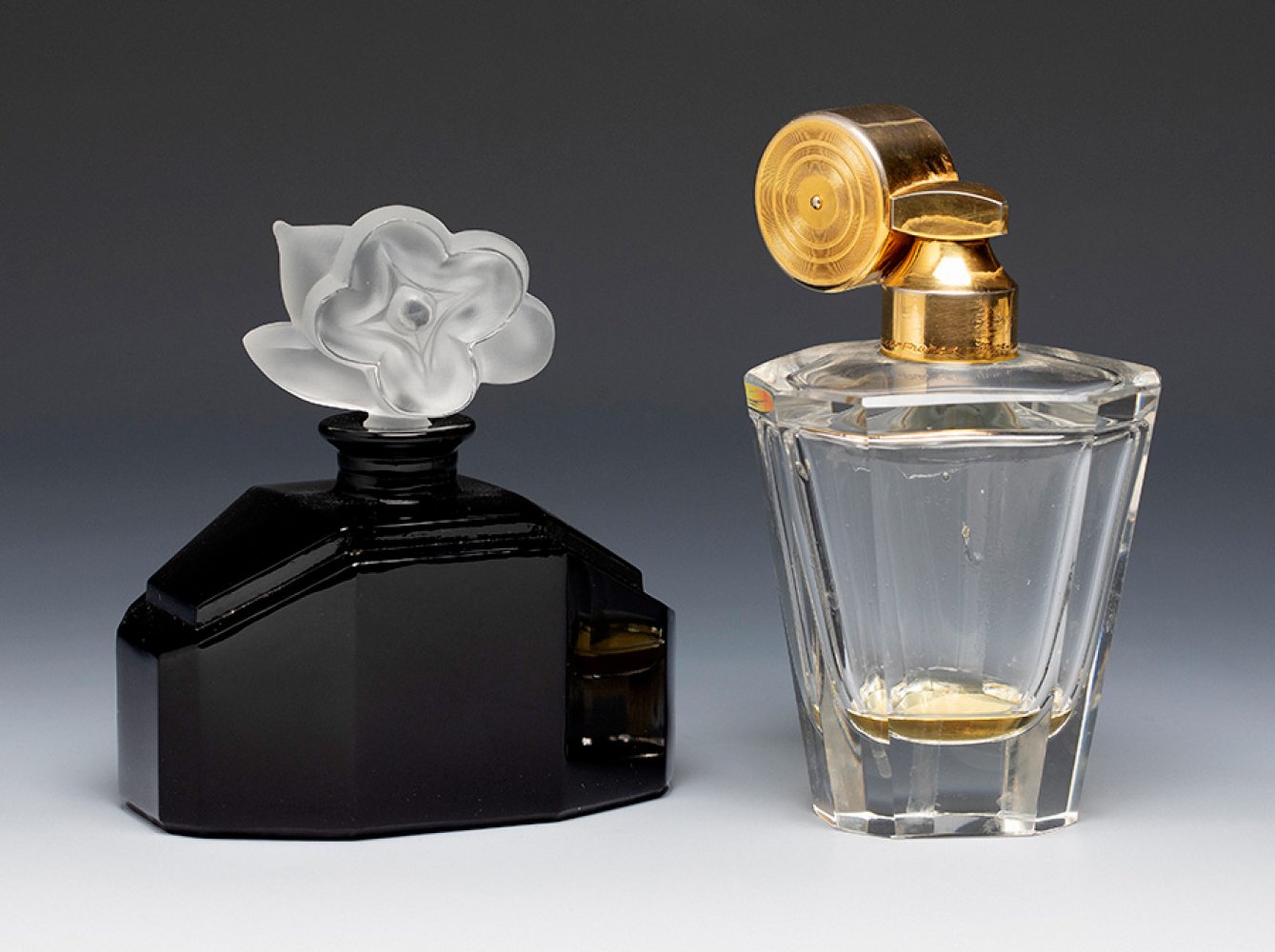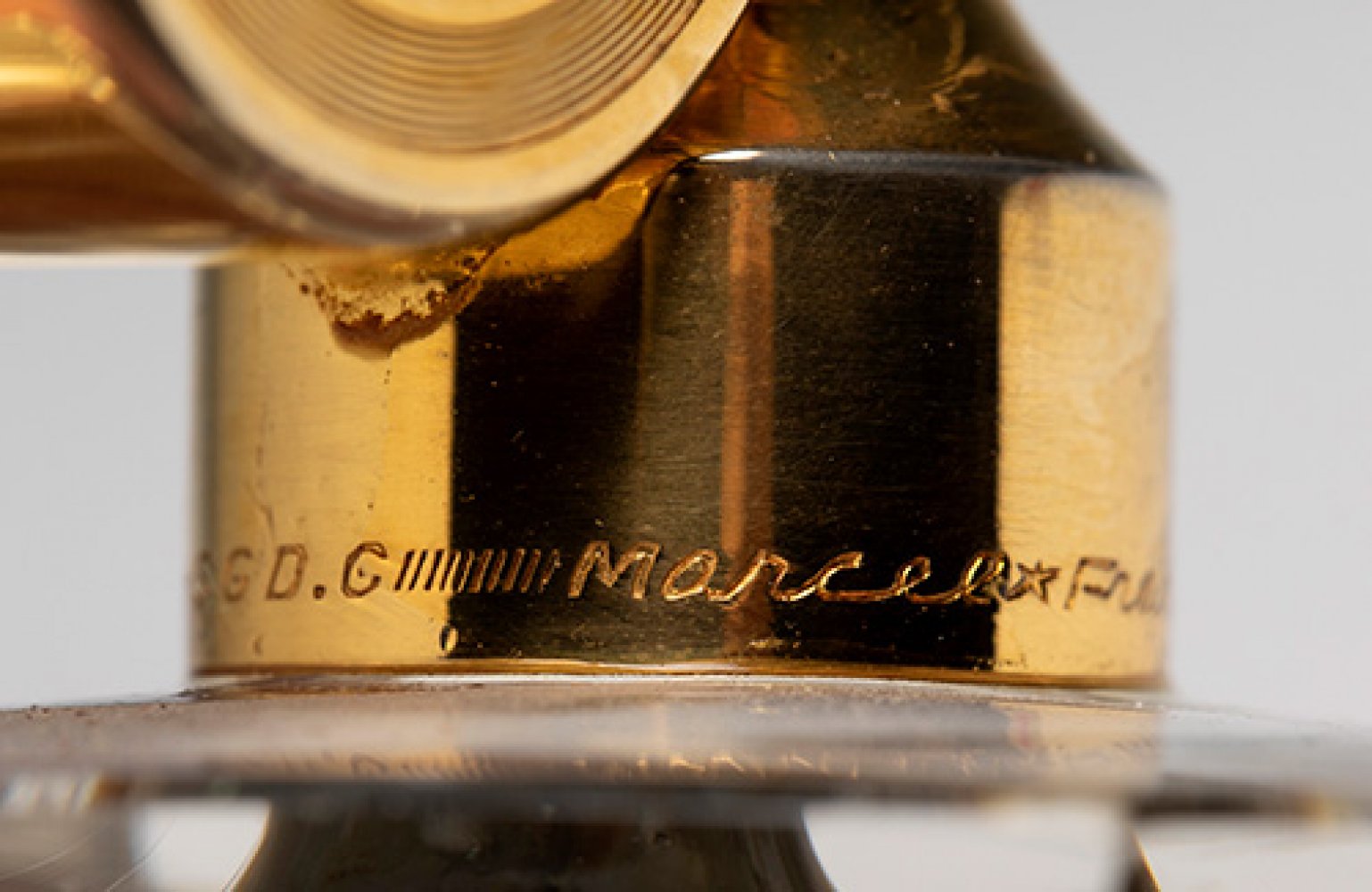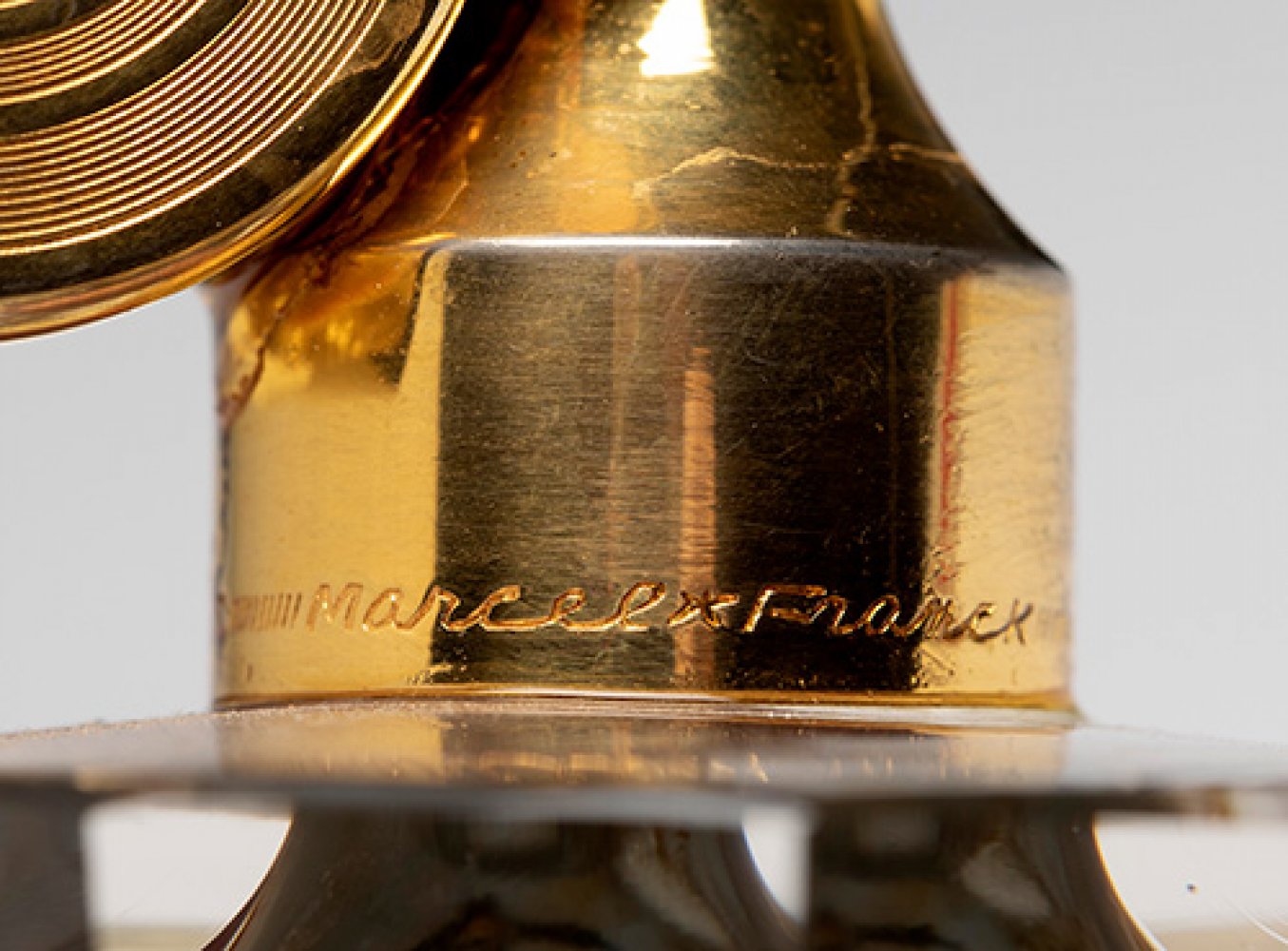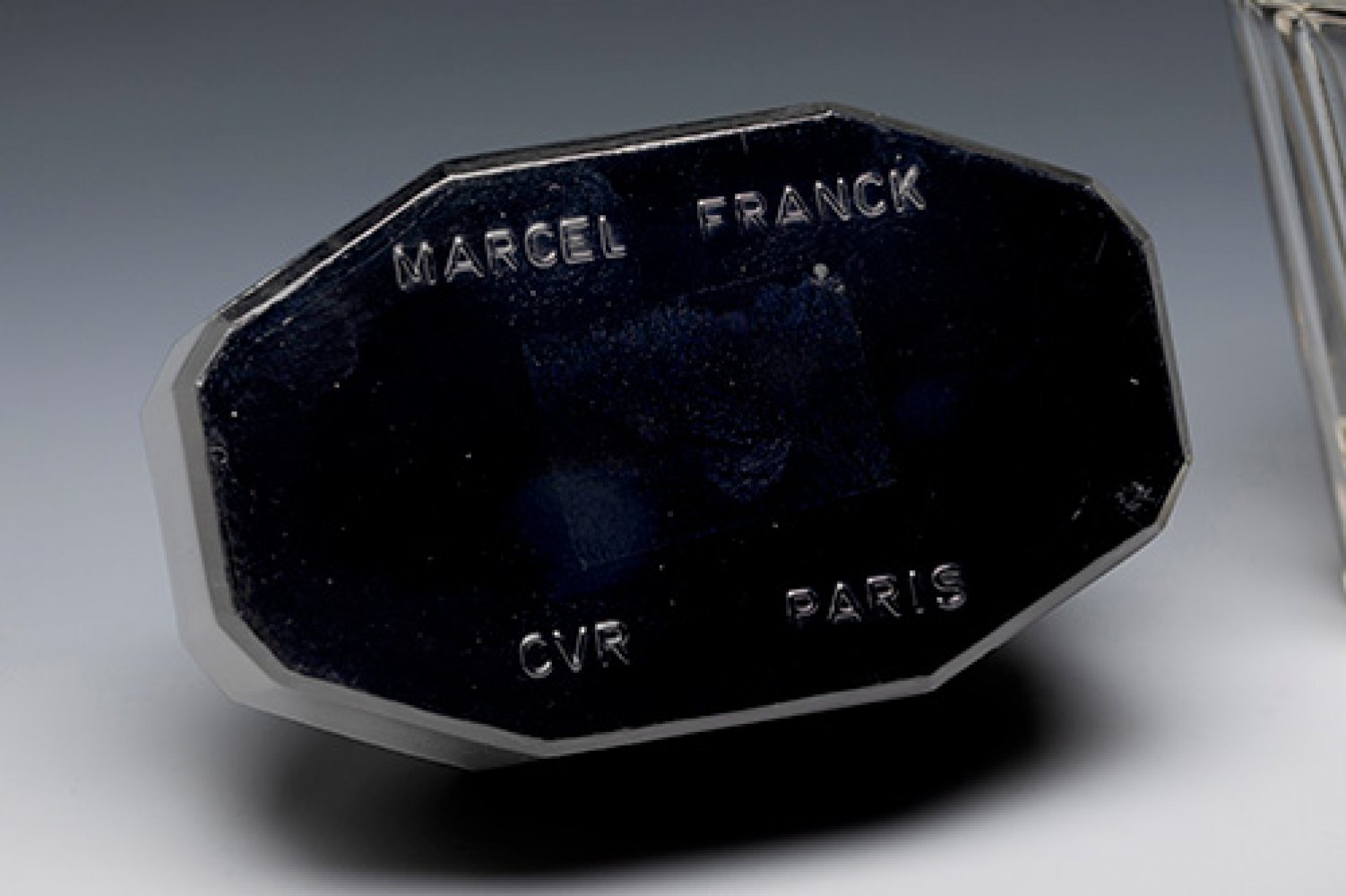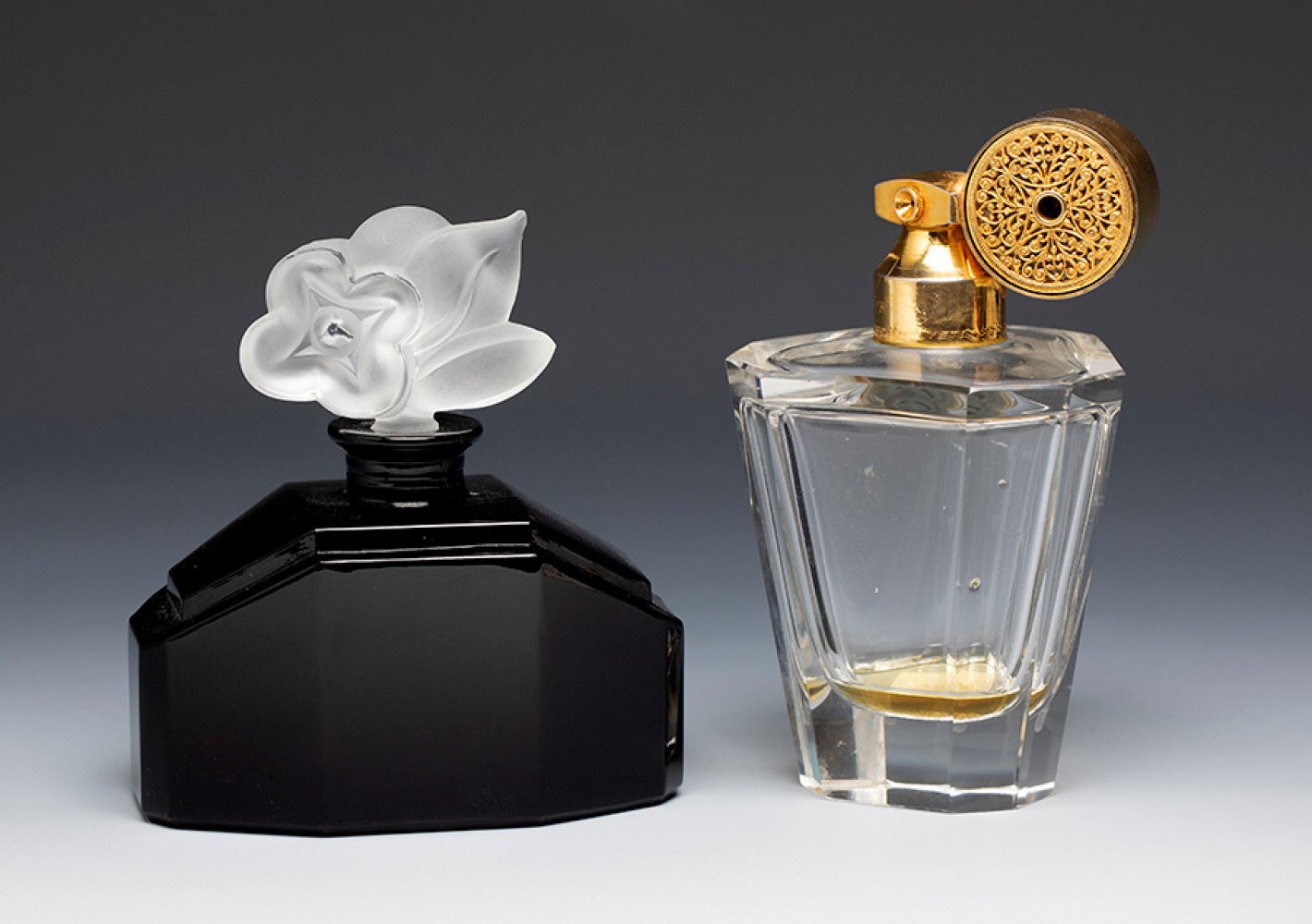8
MARCEL FRANCK perfume holder and atomiser. France, 1940sGlass and gilt metal.Both pieces signed.
1/5
Description
MARCEL FRANCK perfume holder and atomiser. France, 1940s
Glass and gilt metal.
Both pieces signed.
Provenance: Spanish private collection, formed between 1970 and 1995.
Measurements: 11 x 10 x 6 cm (perfume box); 12,5 x 7,5 x 7,5 x 7,5 cm (atomiser).
Marcel Franck perfume box and atomizer, Art Deco period. The perfume box with black glass container and frosted glass stopper in the shape of a flower. The atomiser model "Escale" in translucent glass, possibly Baccarat, with faceted decoration. Inscriptions on both pieces, "Marcel Frank CVR Paris" on the perfume box and on the atomiser on the metal part.
Marcel Franck was founded in 1882 by Léopold Franck who believed in the future of the perfume vaporiser (atomiser) and bet on a business that would mass produce these devices. Franck's original customers were hairdressers and beauty product salesmen located near his workshop in Paris. As the business prospered, his customers came to include all the major Parisian department stores, including Le Bon marché, Le Printemps and Le Galeries Lafayette. When Léopold Franck died in 1907, the business was transferred to the capable hands of his son, Marcel, hence "Marcel Franck". Under Marcel's leadership, business relationships were established with leading glass bottle manufacturers throughout Europe, particularly in Italy, Germany, Austria and Bohemia, as well as France. Fraanck also relied on the talents of unknown French craftsmen, some of whom became famous as a result of this contact: Gabriel Argy-Rousseau, for example.
While Marcel Franck did some work for major perfume houses such as Guerlain, Molinard and d'Orsay, and provided some assemblies for Baccarat, Saint-Louis, Gallé and Lalique, the aim of the business was always to develop products that promoted the "Marcel Franck" rather than allowing the company to become just another anonymous subcontractor to the famous. Technical development helped keep Marcel Franck competitive. The quality and durability of Marcel Franck atomisers were important considerations. From the mid-1920s, brass was used exclusively, with a chrome or gold plating over it.
Glass and gilt metal.
Both pieces signed.
Provenance: Spanish private collection, formed between 1970 and 1995.
Measurements: 11 x 10 x 6 cm (perfume box); 12,5 x 7,5 x 7,5 x 7,5 cm (atomiser).
Marcel Franck perfume box and atomizer, Art Deco period. The perfume box with black glass container and frosted glass stopper in the shape of a flower. The atomiser model "Escale" in translucent glass, possibly Baccarat, with faceted decoration. Inscriptions on both pieces, "Marcel Frank CVR Paris" on the perfume box and on the atomiser on the metal part.
Marcel Franck was founded in 1882 by Léopold Franck who believed in the future of the perfume vaporiser (atomiser) and bet on a business that would mass produce these devices. Franck's original customers were hairdressers and beauty product salesmen located near his workshop in Paris. As the business prospered, his customers came to include all the major Parisian department stores, including Le Bon marché, Le Printemps and Le Galeries Lafayette. When Léopold Franck died in 1907, the business was transferred to the capable hands of his son, Marcel, hence "Marcel Franck". Under Marcel's leadership, business relationships were established with leading glass bottle manufacturers throughout Europe, particularly in Italy, Germany, Austria and Bohemia, as well as France. Fraanck also relied on the talents of unknown French craftsmen, some of whom became famous as a result of this contact: Gabriel Argy-Rousseau, for example.
While Marcel Franck did some work for major perfume houses such as Guerlain, Molinard and d'Orsay, and provided some assemblies for Baccarat, Saint-Louis, Gallé and Lalique, the aim of the business was always to develop products that promoted the "Marcel Franck" rather than allowing the company to become just another anonymous subcontractor to the famous. Technical development helped keep Marcel Franck competitive. The quality and durability of Marcel Franck atomisers were important considerations. From the mid-1920s, brass was used exclusively, with a chrome or gold plating over it.
Auction Details
Shipping
T&Cs & Important Info
Ask seller a question
MARCEL FRANCK perfume holder and atomiser. France, 1940s
Glass and gilt metal.
Both pieces signed.
Provenance: Spanish private collection, formed between 1970 and 1995.
Measurements: 11 x 10 x 6 cm (perfume box); 12,5 x 7,5 x 7,5 x 7,5 cm (atomiser).
Marcel Franck perfume box and atomizer, Art Deco period. The perfume box with black glass container and frosted glass stopper in the shape of a flower. The atomiser model "Escale" in translucent glass, possibly Baccarat, with faceted decoration. Inscriptions on both pieces, "Marcel Frank CVR Paris" on the perfume box and on the atomiser on the metal part.
Marcel Franck was founded in 1882 by Léopold Franck who believed in the future of the perfume vaporiser (atomiser) and bet on a business that would mass produce these devices. Franck's original customers were hairdressers and beauty product salesmen located near his workshop in Paris. As the business prospered, his customers came to include all the major Parisian department stores, including Le Bon marché, Le Printemps and Le Galeries Lafayette. When Léopold Franck died in 1907, the business was transferred to the capable hands of his son, Marcel, hence "Marcel Franck". Under Marcel's leadership, business relationships were established with leading glass bottle manufacturers throughout Europe, particularly in Italy, Germany, Austria and Bohemia, as well as France. Fraanck also relied on the talents of unknown French craftsmen, some of whom became famous as a result of this contact: Gabriel Argy-Rousseau, for example.
While Marcel Franck did some work for major perfume houses such as Guerlain, Molinard and d'Orsay, and provided some assemblies for Baccarat, Saint-Louis, Gallé and Lalique, the aim of the business was always to develop products that promoted the "Marcel Franck" rather than allowing the company to become just another anonymous subcontractor to the famous. Technical development helped keep Marcel Franck competitive. The quality and durability of Marcel Franck atomisers were important considerations. From the mid-1920s, brass was used exclusively, with a chrome or gold plating over it.
Glass and gilt metal.
Both pieces signed.
Provenance: Spanish private collection, formed between 1970 and 1995.
Measurements: 11 x 10 x 6 cm (perfume box); 12,5 x 7,5 x 7,5 x 7,5 cm (atomiser).
Marcel Franck perfume box and atomizer, Art Deco period. The perfume box with black glass container and frosted glass stopper in the shape of a flower. The atomiser model "Escale" in translucent glass, possibly Baccarat, with faceted decoration. Inscriptions on both pieces, "Marcel Frank CVR Paris" on the perfume box and on the atomiser on the metal part.
Marcel Franck was founded in 1882 by Léopold Franck who believed in the future of the perfume vaporiser (atomiser) and bet on a business that would mass produce these devices. Franck's original customers were hairdressers and beauty product salesmen located near his workshop in Paris. As the business prospered, his customers came to include all the major Parisian department stores, including Le Bon marché, Le Printemps and Le Galeries Lafayette. When Léopold Franck died in 1907, the business was transferred to the capable hands of his son, Marcel, hence "Marcel Franck". Under Marcel's leadership, business relationships were established with leading glass bottle manufacturers throughout Europe, particularly in Italy, Germany, Austria and Bohemia, as well as France. Fraanck also relied on the talents of unknown French craftsmen, some of whom became famous as a result of this contact: Gabriel Argy-Rousseau, for example.
While Marcel Franck did some work for major perfume houses such as Guerlain, Molinard and d'Orsay, and provided some assemblies for Baccarat, Saint-Louis, Gallé and Lalique, the aim of the business was always to develop products that promoted the "Marcel Franck" rather than allowing the company to become just another anonymous subcontractor to the famous. Technical development helped keep Marcel Franck competitive. The quality and durability of Marcel Franck atomisers were important considerations. From the mid-1920s, brass was used exclusively, with a chrome or gold plating over it.
6th of September - Glass & Perfume Collection
Sale Date(s)
Venue Address
Aragón 346, Barcelona
Calle Velázquez 7, Madrid
Carrer de Cirilo Amorós 55, Valencia
Barcelona
08009
Spain
General delivery information available from the auctioneer
Setdart offers Worldwide shipping
PICK UP IN ROOM: You can come and pick up your lots in our offices (Barcelona, Madrid or Valencia). At the moment of the withdrawal, you will be able to accept the current conditions of the lot by means of a document that you will sign.
YOU CAN SEND ANOTHER PERSON TO PICK UP: This person must present a signed authorization that you can find in our web page by accessing from BUY AT SETDART- LOGISTICS-DOWNLOAD AUTHORIZATION DOCUMENT. You can also send an e-mail with the requested data in AUTHORIZATION DOCUMENT to admin@setdart.com
Important Information
25% buyer´s premium
21% buyer´s prmeium at www.setdart.com











